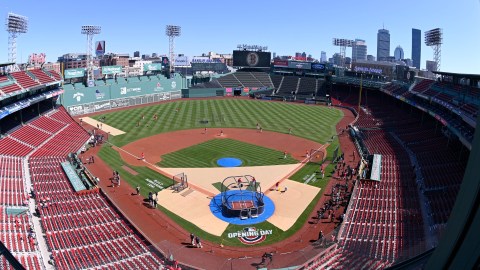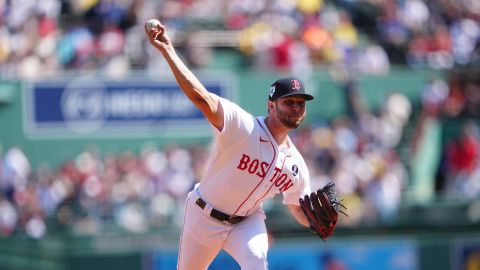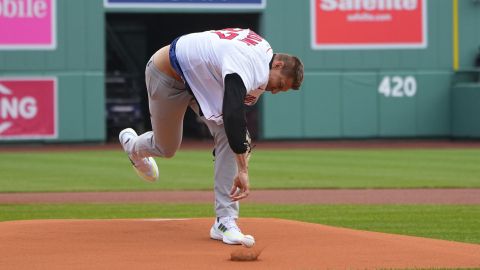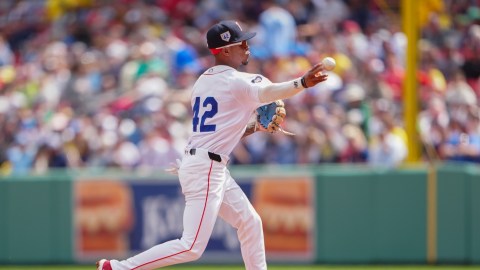The Boston Red Sox exploded for 10 runs in the ninth inning Sunday afternoon on their way to a 17-6 win over the Minnesota Twins. A quick look at the final score obviously seems to indicate a rout.
The reality, however, was that the Red Sox had to scratch and claw their way to a win after Chris Sale’s “worst” start in a Boston uniform. And there was a time in the bottom of the eighth inning — moments before the Sox dropped a 10-burger on the Twins in the ninth — where the game was very much in doubt.
Red Sox manager John Farrell turned to closer Craig Kimbrel with hopes the right-hander would be able to lock down the first five-out save of his career. Kimbrel promptly struck out the two batters he faced in the eighth to end the threat before giving way to the Red Sox fireworks.
It was the latest in a growing line of dominant performances for Kimbrel, who has been nearly unhittable this season. Since blowing a save in Toronto on April 20 (the game Farrell should have left in Sale), Kimbrel has been lights out, allowing only one hit over five innings while striking out nine of the 16 batters he’s faced.
On the season, Kimbrel has struck out more than half the batters he’s faced (26 of 50), and opposing batters are just 5-for-47.
So how’s he doing it? Here are a few educated guesses.
He still has dominant stuff, for starters (or closers)
Someone blessed Kimbrel with a dominant right arm, and he’s using it to its fullest potential this season. You’re obviously a candidate for success when you’re able to throw a laser-beam fastball that routinely sits in the upper 90s complemented by a knee-buckling knuckle-curveball which reaches the upper 80s.
In fact, Kimbrel’s average fastball velocity — 98 mph — is the highest of his career, and he hasn’t thrown a fastball slower than 96.1 mph, per pitchFX data (via Fangraphs).
He’s throwing strikes
One of the biggest problems for Kimbrel in 2016 was the far too occasional difficulty throwing strikes. The right-hander averaged 5.1 walks per nine innings (more than a walk and a half above his career rate), with a strikeout-to-walk ratio of just 2.77, the worst mark he’s had since his rookie season.
He’s peppered the strike zone with astonishing consistency this season, throwing 68 percent of his pitches for strikes, a sizeable jump from his 61 percent rate in 2016.
Because Kimbrel is throwing strikes early and often in counts, it’s putting opposing batters in a position where they can’t be as selective. They can’t wait for a “hittable” fastball and attack. Instead, it’s Kimbrel doing the attacking, with opposing hitters making contact on just 54.7 percent of swings (third among MLB relievers this season).
The spin zone
One of baseball’s newfangled stats ushered in as part of the Statcast era is spin zone. Basically, how fast are you spinning the baseball as a pitcher upon release? The higher spin rate the better, as a high spin rate can make it even tougher to hit. Pitchers with “sneaky fast” fastballs often have high spin rates.
There’s nothing sneaky about Kimbrel’s fastball, but he still boasts one of the highest spin rates in baseball. Kimbrel ranks sixth in average four-seam fastball velocity among all pitchers in baseball, but he’s third in spin rate with his four-seamer.
Making anything out of that information is admittedly hard, but it’s a little easier to understand when you meld it with an at-bat like Sunday when he fanned Max Kepler on three straight fastballs all within centimeters of each other. Kepler got two chances to make an adjustment and still couldn’t catch up to the fastball.

Of course, all of these things are intertwined, and the thought of that breaking ball (and Kimbrel’s ability to once again throw it in the strike zone) also helps 98 mph look even harder … as Manny Machado also can attest.
Clean bill of health
Of course, all of this is made possible by Kimbrel’s good health. The 28-year-old struggled to stay healthy in 2016, highlighted by a knee injury that required surgery and a disabled list stint. He never really seemed himself all season. Additionally, Kimbrel revealed to WEEI.com earlier this season he also dealt with a finger injury, which is kind of a big deal when the prime real estate for a pitcher is from the shoulder to the fingertips.
Kimbrel is healthy now, though, and he’s again performing like the player the Red Sox imagined they were getting last winter: one of the best closers in the game.
Thumbnail photo via Bob DeChiara/USA TODAY Sports Images




